A High-Sensitivity Electrochemical Sensor Based on Polyaniline/Sodium Alginate Composite for Pb and Cd Detection †
Abstract
1. Introduction
2. Materials and Methods
2.1. Materials
2.2. Preparation of PANI/SA
2.3. Characterization
3. Results and Discussion
3.1. Structural and Optical Characterization
3.2. Electrochemical Characterization
3.3. Detection of Heavy Metals (Pb(II) and Cd(II))
3.4. Selectivity, Stability, and Reproducibility
4. Conclusions
Author Contributions
Funding
Data Availability Statement
Conflicts of Interest
References
- Nriagu, J.O.; Pacyna, J.M. Quantitative assessment of worldwide contamination of air, water and soils by trace metals. Nature 1998, 333, 134–139. [Google Scholar] [CrossRef]
- Johri, N.; Jacquillet, G.; Unwin, R. Heavy metal poisoning: The effects of cadmium on the kidney. BioMetals 2010, 23, 783–792. [Google Scholar] [CrossRef]
- Triunfante, P.; Soares, M.E.; Santos, A.; Tavares, S.; Carmo, H.; Bastos, M.D.L. Mercury fatal intoxication: Two case reports. Forensic Sci. Int. 2009, 184, e1–e6. [Google Scholar] [CrossRef]
- Aragay, G.; Pons, J.; Merkoçi, A. Recent Trends in Macro-, Micro-, and Nanomaterial-Based Tools and Strategies for Heavy-Metal Detection. Chem. Rev. 2011, 111, 3433–3458. [Google Scholar] [CrossRef] [PubMed]
- Cui, L.; Wu, J.; Ju, H. Electrochemical sensing of heavy metal ions with inorganic, organic and bio-materials. Biosens. Bioelectron. 2015, 63, 276–286. [Google Scholar] [CrossRef] [PubMed]
- Okano, G.; Igarashi, S.; Yamamoto, Y.; Saito, S.; Takagai, Y.; Ohtomo, T.; Kimura, T.; Ohno, T.; Oka, Y. HPLC-spectrophotometric detection of trace heavy metals via ‘cascade’ separation and concentration. Int. J. Environ. Anal. Chem. 2015, 95, 135–144. [Google Scholar] [CrossRef]
- Moretto, L.M.; Kalcher, K. (Eds.) Environmental Analysis by Electrochemical Sensors and Biosensors: Fundamentals; Springer: New York, NY, USA, 2014. [Google Scholar] [CrossRef]
- Kushwaha, C.S.; Singh, V.K.; Shukla, S.K. Electrochemically triggered sensing and recovery of mercury over sodium alginate grafted polyaniline. New J. Chem. 2021, 45, 10626–10635. [Google Scholar] [CrossRef]
- Sun, J.; Tan, H. Alginate-Based Biomaterials for Regenerative Medicine Applications. Materials 2013, 6, 1285–1309. [Google Scholar] [CrossRef] [PubMed]
- Lee, K.Y.; Mooney, D.J. Alginate: Properties and biomedical applications. Prog. Polym. Sci. 2012, 37, 106–126. [Google Scholar] [CrossRef]
- Majhi, D.; Patra, B.N. Polyaniline and sodium alginate nanocomposite: A pH-responsive adsorbent for the removal of organic dyes from water. RSC Adv. 2020, 10, 43904–43914. [Google Scholar] [CrossRef]
- Yu, Y.; Zhihuai, S.; Chen, S.; Bian, C.; Chen, W.; Xue, G. Facile Synthesis of Polyaniline−Sodium Alginate Nanofibers. Langmuir 2006, 22, 3899–3905. [Google Scholar] [CrossRef] [PubMed]
- Ke, Y.-C.; Chen, T.-C.; Tang, R.-C.; Lin, J.-N.; Lin, F.-H. Development of resveratrol with thiolated alginate as a supplement to prevent nonalcoholic fatty liver disease (NAFLD). APL Bioeng. 2022, 6, 016102. [Google Scholar] [CrossRef] [PubMed]
- Zhang, X.; Sheng, N.; Wang, L.; Tan, Y.; Liu, C.; Xia, Y.; Nie, Z.; Sui, K. Supramolecular nanofibrillar hydrogels as highly stretchable, elastic and sensitive ionic sensors. Mater. Horiz. 2019, 6, 326–333. [Google Scholar] [CrossRef]
- Ke, X.; Yang, F.; Huang, H.; Zhao, R.; Huang, J.; Ji, J.; Li, L. Stable polyaniline/sodium alginate/graphene oxide composite hydrogels as binder-free supercapacitor electrodes. Ionics 2022, 28, 5633–5641. [Google Scholar] [CrossRef]
- Karthik, R.; Meenakshi, S. Removal of Cr(VI) ions by adsorption onto sodium alginate-polyaniline nanofibers. Int. J. Biol. Macromol. 2015, 72, 711–717. [Google Scholar] [CrossRef]
- Li, Y.; Zhao, X.; Xu, Q.; Zhang, Q.; Chen, D. Facile Preparation and Enhanced Capacitance of the Polyaniline/Sodium Alginate Nanofiber Network for Supercapacitors. Langmuir 2011, 27, 6458–6463. [Google Scholar] [CrossRef]
- Song, E.; Choi, J.-W. Conducting Polyaniline Nanowire and Its Applications in Chemiresistive Sensing. Nanomaterials 2013, 3, 498–523. [Google Scholar] [CrossRef] [PubMed]
- Zhang, S.; Sun, G.; He, Y.; Fu, R.; Gu, Y.; Chen, S. Preparation, Characterization, and Electrochromic Properties of Nanocellulose-Based Polyaniline Nanocomposite Films. ACS Appl. Mater. Interfaces 2017, 9, 16426–16434. [Google Scholar] [CrossRef]
- Deshmukh, M.A.; Celiesiute, R.; Ramanaviciene, A.; Shirsat, M.D.; Ramanavicius, A. EDTA_PANI/SWCNTs nanocomposite modified electrode for electrochemical determination of copper (II), lead (II) and mercury (II) ions. Electrochim. Acta 2018, 259, 930–938. [Google Scholar] [CrossRef]
- Wang, D.; Zhang, F.; Tang, J. Sodium Alginate Decorated Carbon Nanotubes-Graphene Composite Aerogel for Heavy Metal Ions Detection. Electrochemistry 2015, 83, 84–90. [Google Scholar] [CrossRef]
- Garg, N.; Deep, A.; Sharma, A.L. Simultaneous detection of Lead and Cadmium using a composite of Zeolite Imidazole Framework and Reduced Graphene Oxide (ZIF-67/rGO) via electrochemical approach. Environ. Eng. Res. 2022, 28, 220269. [Google Scholar] [CrossRef]
- Ahmed, M.M.N.; Bodowara, F.S.; Zhou, W.; Penteado, J.F.; Smeltz, J.L.; Pathirathna, P. Electrochemical detection of Cd(II) ions in complex matrices with nanopipets. RSC Adv. 2022, 12, 1077–1083. [Google Scholar] [CrossRef]
- Levanen, G.; Dali, A.; Leroux, Y.; Lupoi, T.; Betelu, S.; Michel, K.; Ababou-Girard, S.; Hapiot, P.; Dahech, I.; Cristea, C.; et al. Specific electrochemical sensor for cadmium detection: Comparison between monolayer and multilayer functionalization. Electrochim. Acta 2023, 464, 142962. [Google Scholar] [CrossRef]
- El-Fatah, G.A.; Magar, H.S.; Hassan, R.Y.A.; Mahmoud, R.; Farghali, A.A.; Hassouna, M.E.M. A novel gallium oxide nanoparticles-based sensor for the simultaneous electrochemical detection of Pb2+, Cd2+ and Hg2+ ions in real water samples. Sci. Rep. 2022, 12, 20181. [Google Scholar] [CrossRef] [PubMed]
- Mohammed, R.H.R.; Hassan, R.Y.A.; Mahmoud, R.; Farghali, A.A.; Hassouna, M.E.M. Electrochemical determination of cadmium ions in biological and environmental samples using a newly developed sensing platform made of nickel tungstate-doped multi-walled carbon nanotubes. J. Appl. Electrochem. 2024, 54, 657–668. [Google Scholar] [CrossRef]

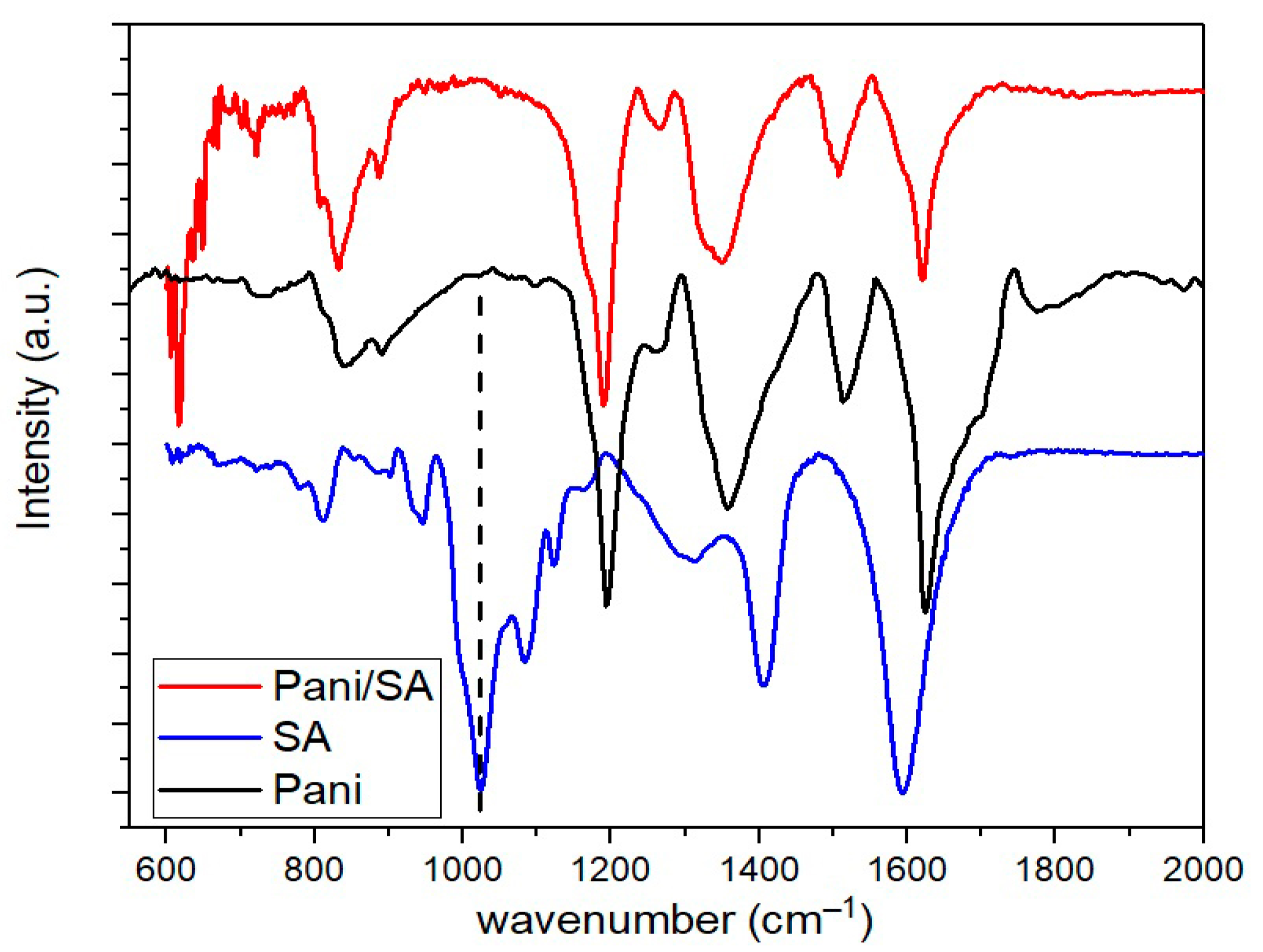
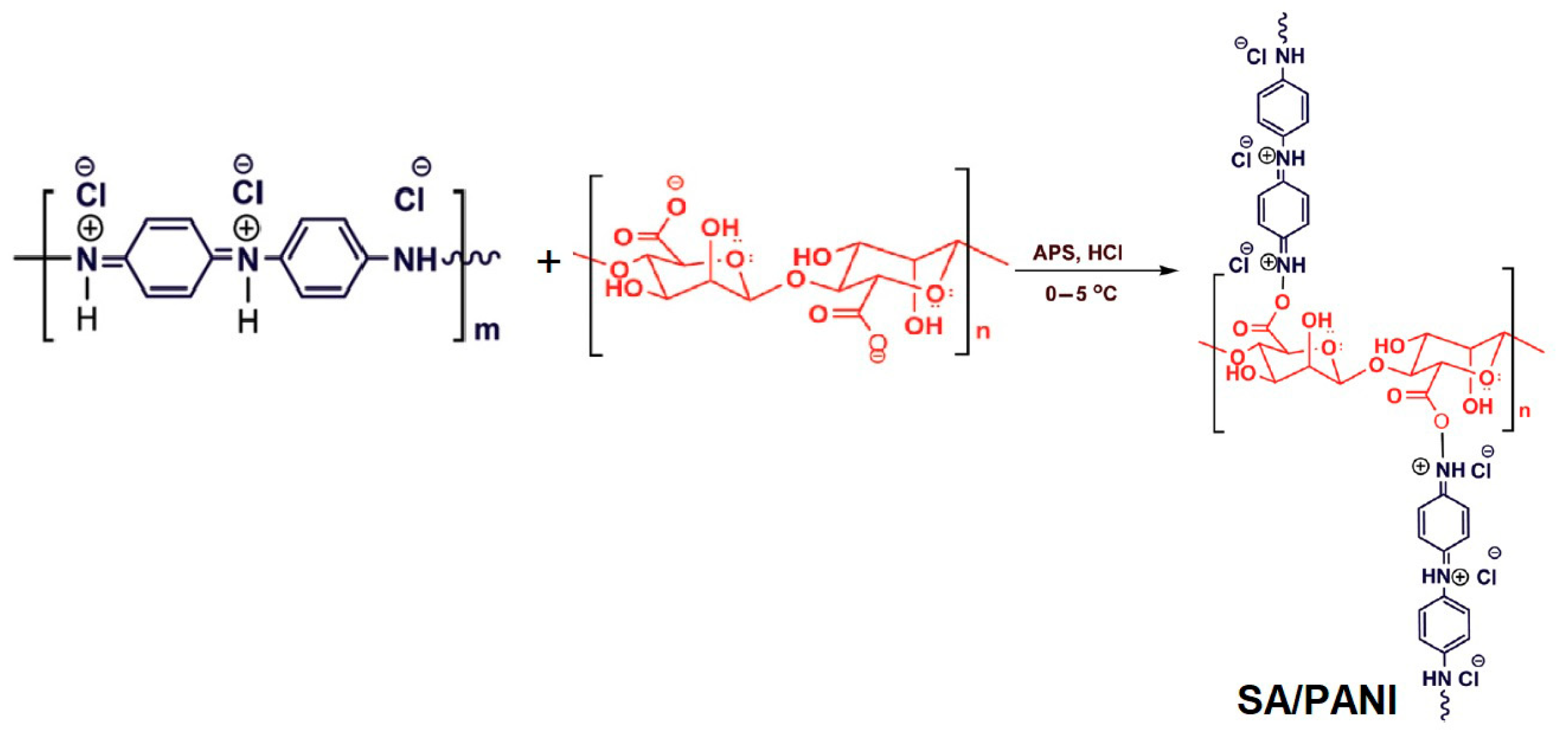
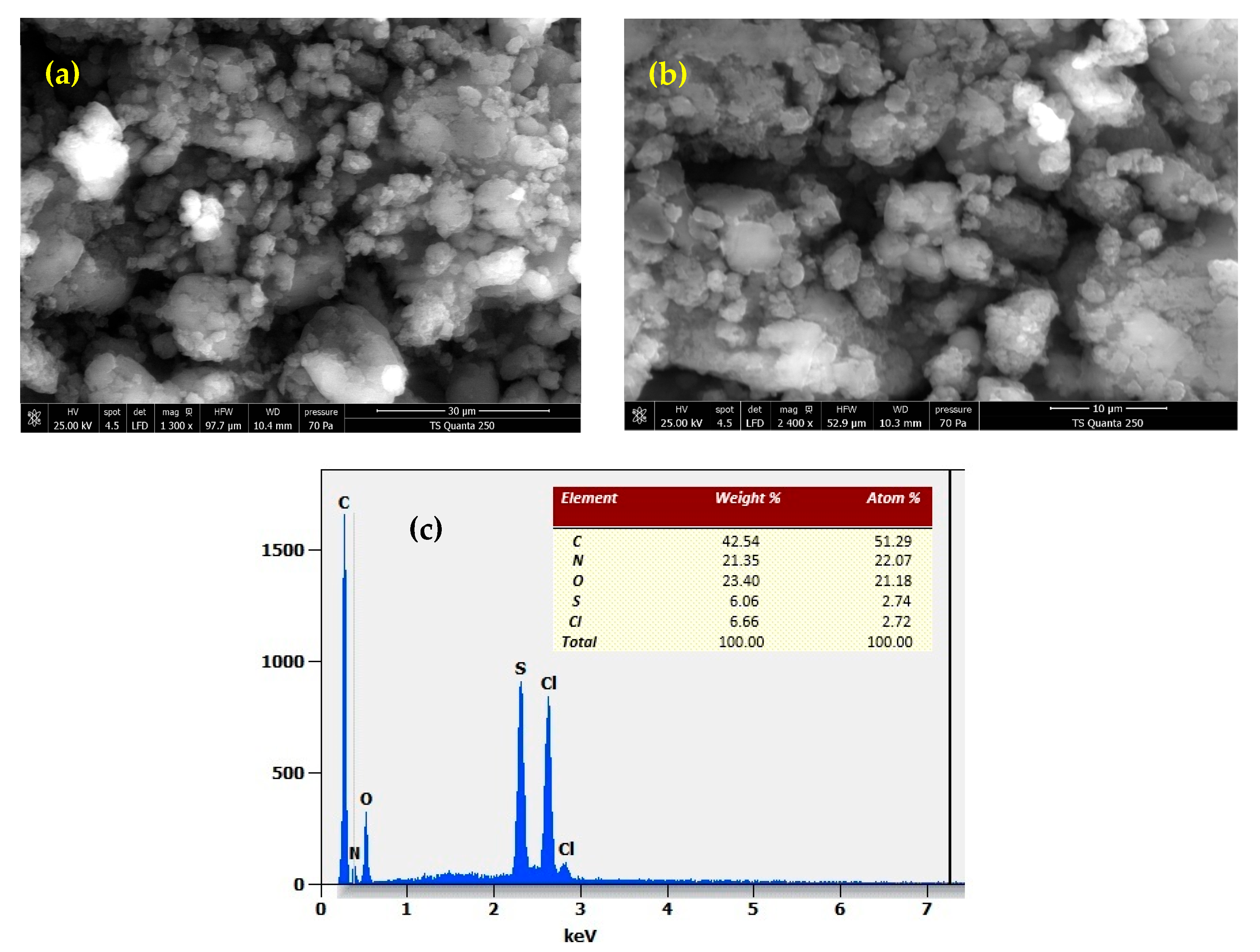
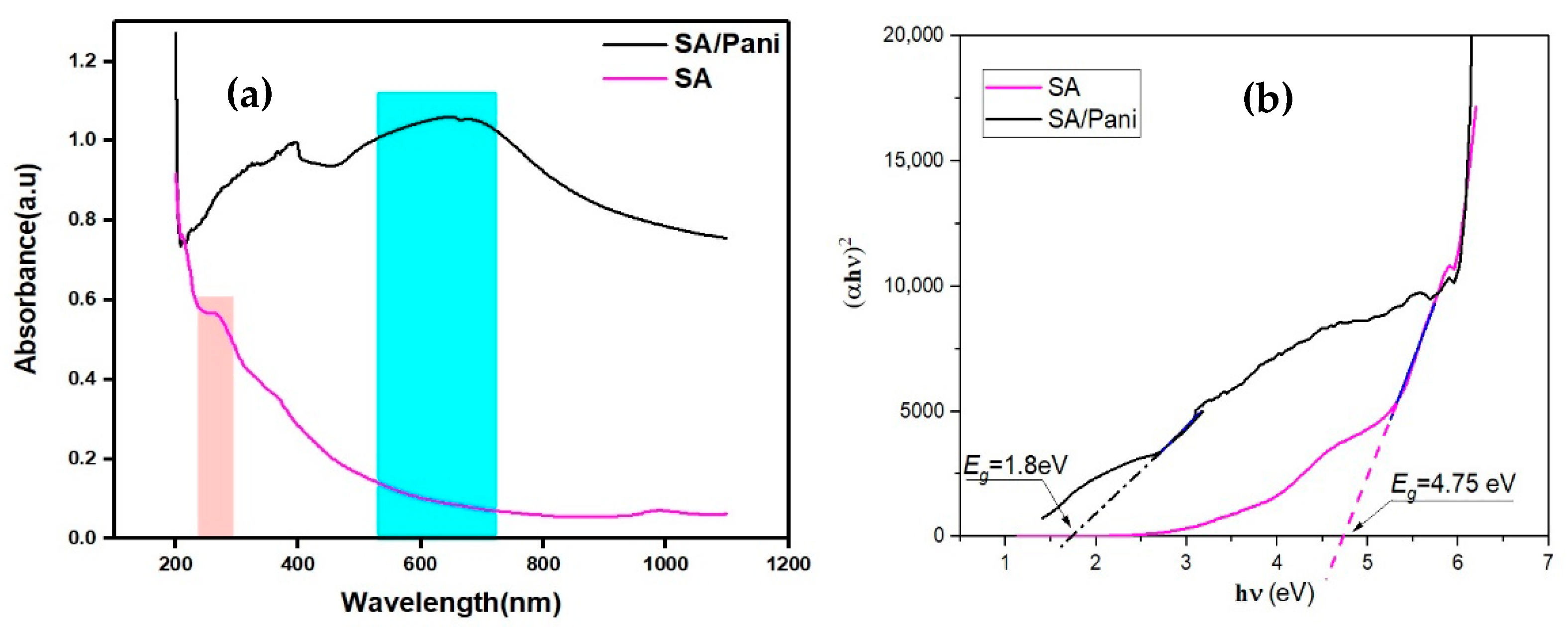
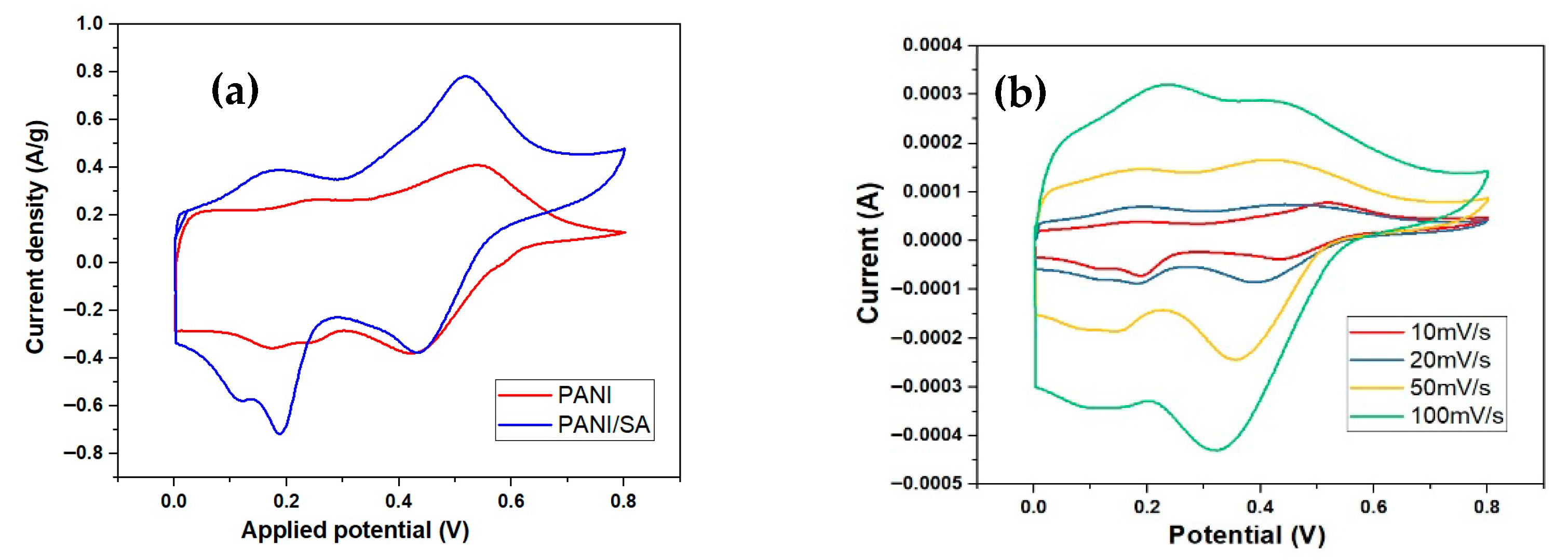

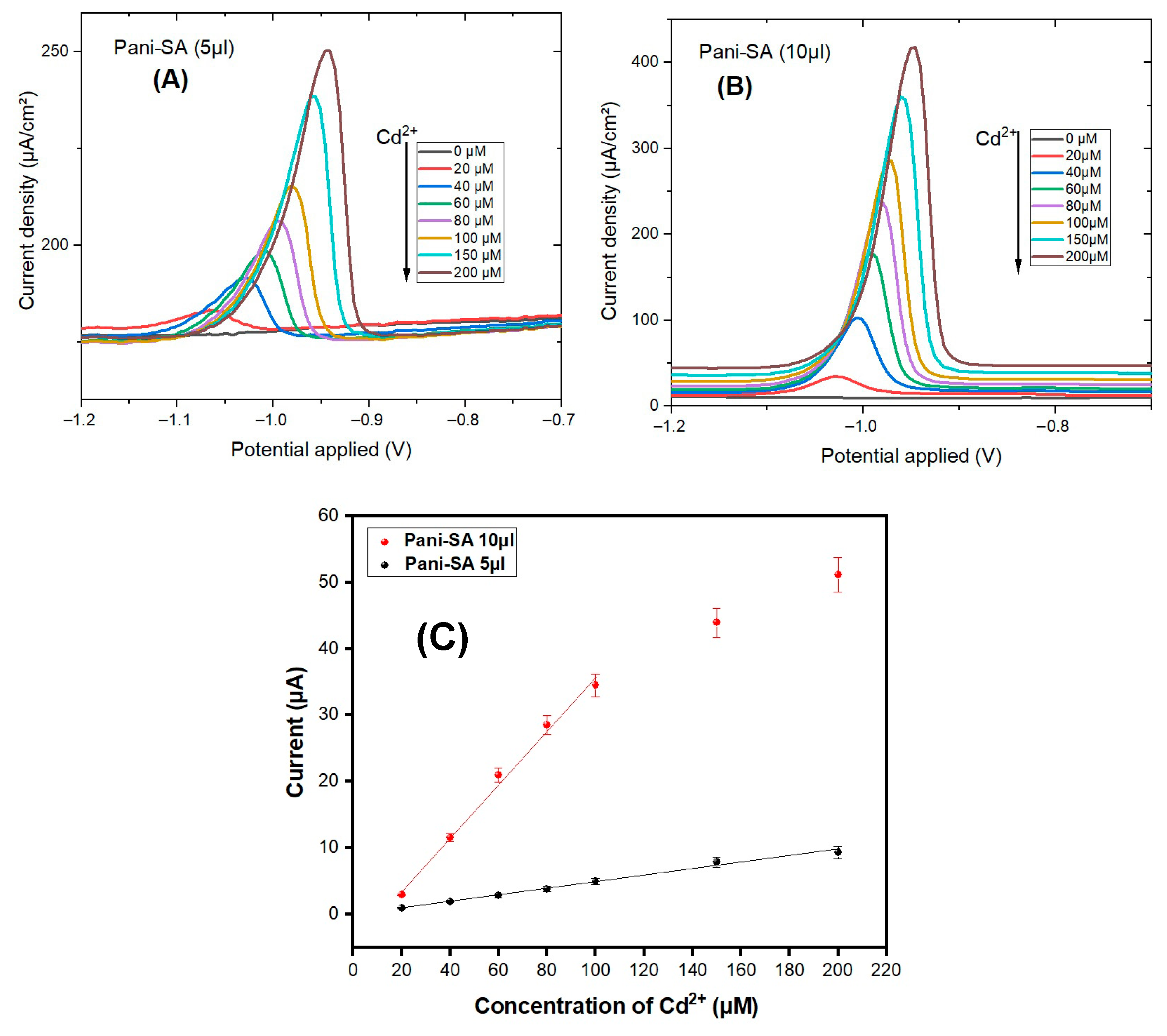

| Electrode | Composition | Sensitivity (µA µM−1) | Ref. |
|---|---|---|---|
| PANI/SA | PANI/SA on SPCE | 0.52 | This work |
| APTE-Mono@GC | Monolayer of APTE on GCE via diazonium grafting | 3.00 | [24] |
| Ga2O3NPs/CPE | Gallium oxide nanoparticles mixed in carbon paste | 1.250 | [25] |
| NiWO4/MWCNT/CPE | Nickel tungstate + multiwalled carbon nanotubes in carbon paste | 0.038 | [26] |
| Nanopipet/ITIES | nanopipet-based ITIES sensing platforms with 1,10-phenanthroline | 0.127 × 10−3 | [23] |
Disclaimer/Publisher’s Note: The statements, opinions and data contained in all publications are solely those of the individual author(s) and contributor(s) and not of MDPI and/or the editor(s). MDPI and/or the editor(s) disclaim responsibility for any injury to people or property resulting from any ideas, methods, instructions or products referred to in the content. |
© 2025 by the authors. Licensee MDPI, Basel, Switzerland. This article is an open access article distributed under the terms and conditions of the Creative Commons Attribution (CC BY) license (https://creativecommons.org/licenses/by/4.0/).
Share and Cite
Wali, R.; Ghorbel, N.; Maalej, R.; Arous, M. A High-Sensitivity Electrochemical Sensor Based on Polyaniline/Sodium Alginate Composite for Pb and Cd Detection. Eng. Proc. 2025, 106, 2. https://doi.org/10.3390/engproc2025106002
Wali R, Ghorbel N, Maalej R, Arous M. A High-Sensitivity Electrochemical Sensor Based on Polyaniline/Sodium Alginate Composite for Pb and Cd Detection. Engineering Proceedings. 2025; 106(1):2. https://doi.org/10.3390/engproc2025106002
Chicago/Turabian StyleWali, Ratiba, Nouha Ghorbel, Ramzi Maalej, and Mourad Arous. 2025. "A High-Sensitivity Electrochemical Sensor Based on Polyaniline/Sodium Alginate Composite for Pb and Cd Detection" Engineering Proceedings 106, no. 1: 2. https://doi.org/10.3390/engproc2025106002
APA StyleWali, R., Ghorbel, N., Maalej, R., & Arous, M. (2025). A High-Sensitivity Electrochemical Sensor Based on Polyaniline/Sodium Alginate Composite for Pb and Cd Detection. Engineering Proceedings, 106(1), 2. https://doi.org/10.3390/engproc2025106002








